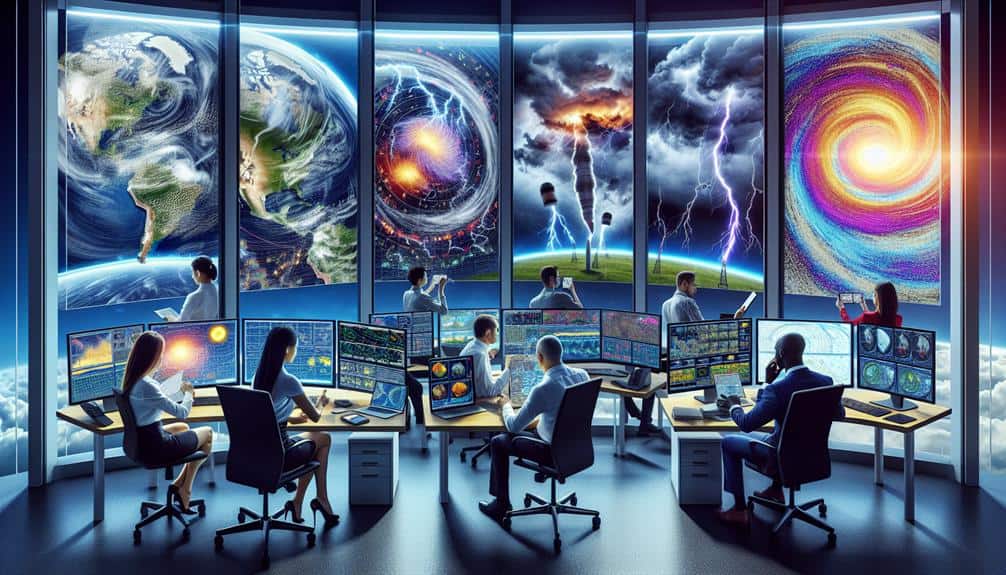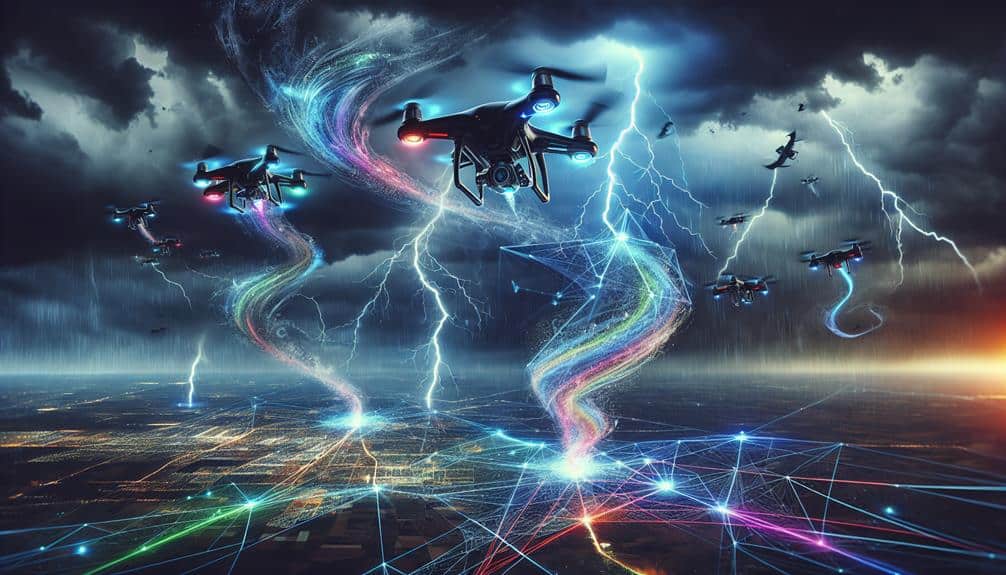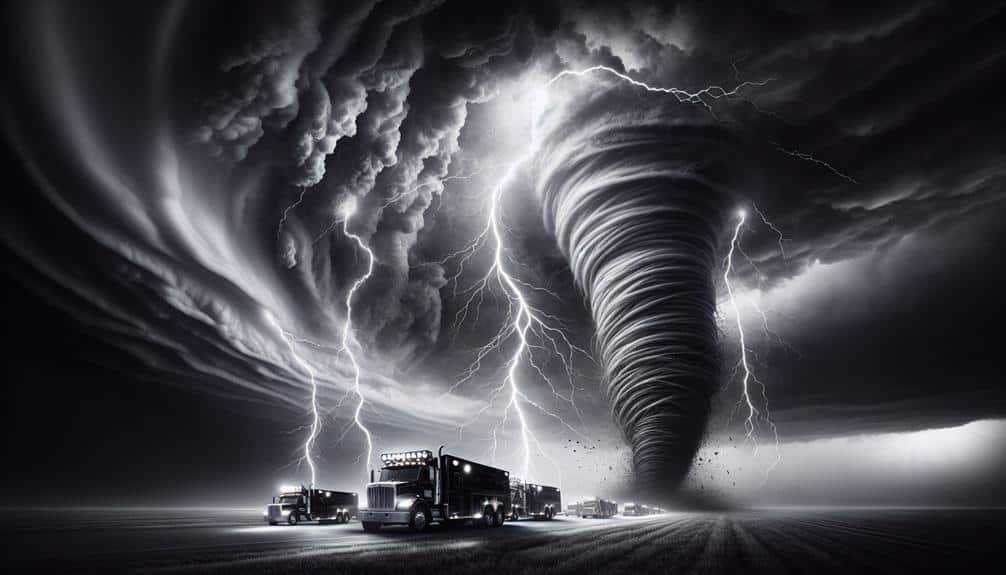We use the Storm Chaser Network to monitor and predict severe weather by leveraging advanced meteorological tools and real-time data. Our network consists of mobile weather stations, aerial drones, and satellite imagery, all equipped with high-resolution sensors for precise data collection. This technical setup enables accurate storm tracking and prediction. With the aid of predictive analytics and machine learning, we enhance forecast accuracy and improve community safety. By sharing real-time data, we guarantee that meteorologists and emergency services have the latest information for proactive measures. Learn how this integration of technology and data serves our goal.
Key Points
- Utilizes mobile weather stations, drones, and satellites to collect and analyze real-time meteorological data.
- Enhances storm tracking accuracy with advanced radar systems and predictive analytics tools.
- Comprises meteorologists, tech enthusiasts, and adventurers dedicated to understanding and predicting severe weather.
- Integrates data from various sources to refine weather prediction models using machine learning techniques.
Understanding Storm Chaser Networks
Storm chaser networks are collaborative groups that utilize advanced meteorological tools and real-time data to monitor and analyze severe weather events. By leveraging cutting-edge technology, we can enhance storm tracking accuracy and provide timely updates. These networks comprise passionate meteorologists, tech enthusiasts, and adventurers who share a common goal: to understand and predict severe weather while staying safe.
Our storm tracking efforts hinge on integrating data from various sources, such as Doppler radar, satellite imagery, and ground-based observations. We aggregate this data in real-time, allowing for dynamic, precise tracking of storm systems. This thorough data analysis helps us identify patterns that could signal the development of tornadoes, hurricanes, or other severe weather phenomena.
In our quest for freedom and safety, we rely on sophisticated modeling software to simulate potential storm paths and impacts. These tools provide actionable insights, guiding us in making informed decisions during storm chasing missions. By continuously refining our data analysis techniques, we enhance our ability to predict and respond to severe weather, ensuring that we remain ahead of the storm and better prepared to protect lives and property.
Key Components of the Network
The key components of our storm chaser network include high-resolution Doppler radar systems, advanced satellite monitoring, and real-time ground-based sensor arrays. These elements work synergistically to provide thorough storm tracking and data analysis.
Our high-resolution Doppler radar systems are critical for detecting wind patterns and precipitation intensity, allowing us to predict storm evolution with pinpoint accuracy. This radar data feeds directly into our models, enhancing our ability to forecast severe weather events.
Advanced satellite monitoring offers a macro perspective, capturing large-scale atmospheric phenomena. With geostationary and polar-orbiting satellites, we can observe storm development from space, tracking cloud formations, temperature gradients, and moisture levels. This satellite data is indispensable for verifying ground-based observations and refining our predictive algorithms.
Real-time ground-based sensor arrays, including anemometers, barometers, and rain gauges, provide localized, precise measurements of atmospheric conditions. These sensors are strategically placed in storm-prone areas to gather continuous data on wind speed, pressure changes, and rainfall. Integrating these measurements into our network facilitates dynamic and responsive storm tracking.
How Data Is Collected
We collect data through a combination of mobile weather stations, aerial drone surveillance, and satellite imagery analysis.
Mobile weather stations provide real-time atmospheric metrics, while drones offer high-resolution visual and thermal data.
Satellite imagery enhances our spatial analysis, allowing for thorough monitoring of storm patterns.
Mobile Weather Stations
Mobile weather stations collect data through a combination of sensors and instruments that measure variables such as temperature, humidity, wind speed, and atmospheric pressure. These mobile units are essential for achieving high data accuracy, enabling us to make precise weather predictions and improve our models.
With remote access capabilities, we can monitor and retrieve real-time data from these stations regardless of our location, providing a significant advantage in dynamic weather conditions.
In emergency response scenarios, the rapid deployment of mobile weather stations is vital. They allow us to gather localized data that's crucial for immediate decision-making and efficient resource allocation. By visualizing the data in real-time, we can better understand how a storm is evolving, assess risks, and issue timely warnings to affected populations.
For instance, detailed data visualization helps us to identify wind patterns and potential areas of flooding, ensuring that emergency teams can act swiftly and effectively.
Additionally, integrating mobile weather station data into our broader storm chaser network enhances our overall forecasting capabilities. This integration allows for seamless data sharing and collaboration among various teams, ultimately empowering us with the information needed to protect lives and property.
Aerial Drone Surveillance
Utilizing aerial drone surveillance, we gather essential meteorological data by deploying advanced sensors that measure atmospheric conditions from various altitudes. Our drones, equipped with state-of-the-art technology, provide a diverse range of data, including wind speed, temperature, humidity, and barometric pressure. This allows us to map weather patterns accurately and predict severe weather events with higher precision.
The drone capabilities extend to real-time data transmission, enabling us to make swift decisions during critical weather conditions. Employing sophisticated surveillance techniques, we can reach altitudes and areas that are otherwise inaccessible, ensuring thorough data collection. This freedom to explore and monitor vast regions enhances our understanding of storm dynamics and potential impacts.
Here's what our aerial drone surveillance offers:
- High-resolution imaging: Captures detailed visual data for cloud formation and storm development.
- Thermal sensors: Measure temperature variations at different atmospheric levels.
- LIDAR technology: Maps wind patterns and turbulence with precision.
- Real-time data relay: Provides immediate updates for dynamic weather tracking.
Satellite Imagery Analysis
In addition to our aerial drone surveillance, satellite imagery analysis plays an important role in collecting detailed meteorological data by capturing high-resolution images of weather systems from space. We leverage these images to analyze cloud formations, precipitation patterns, and storm trajectories. Satellites equipped with advanced sensors and cameras provide us with real-time data, offering a thorough view of atmospheric conditions over vast areas.
Our satellite imagery analysis involves processing data from various spectral bands, including visible, infrared, and microwave. By examining these different bands, we can detect temperature variations, moisture content, and wind speeds. This multi-faceted approach allows us to refine our weather prediction models, enhancing their accuracy and reliability.
The data collected from satellites are integrated with other meteorological observations, such as ground-based radar and drone data, to create a holistic understanding of weather phenomena. Using algorithms and machine learning techniques, we can identify patterns and predict the development of severe weather events, such as hurricanes, tornadoes, and thunderstorms, with greater precision.
Role of Technology in Monitoring
In our storm chaser network, technology plays a pivotal role in monitoring weather patterns. We leverage real-time data collection and advanced radar systems to capture critical information, enabling precise and immediate analysis.
Employing predictive analytics tools, we can forecast storm developments with greater accuracy, enhancing our ability to respond effectively.
Real-Time Data Collection
Cutting-edge sensors and communication technologies are revolutionizing real-time data collection for storm monitoring. We're leveraging these advancements to enhance data accuracy and refine our monitoring techniques. By integrating GPS-enabled devices, mobile weather stations, and drones, we can gather precise, real-time meteorological data even in the most remote locations. This network collaboration ensures we're sharing vital information swiftly, necessary for timely emergency response.
Our storm chaser network thrives on the seamless integration of various technologies. The following components highlight the crucial tools and methods we use:
- GPS-Enabled Sensors: These devices provide accurate location data, pivotal for mapping storm paths.
- Mobile Weather Stations: Deployed on the ground, these stations collect localized weather data like temperature, humidity, and wind speed.
- Drones: Equipped with atmospheric sensors, drones fly into storm systems to gather data from areas that are otherwise inaccessible.
- Satellite Imagery: Offers a bird's-eye view of storm development, aiding in thorough analysis.
Advanced Radar Systems
Our network's effectiveness is further enhanced by advanced radar systems, which provide high-resolution data important for detailed storm analysis and prediction. Radar technology allows us to capture intricate details of weather patterns, offering unmatched insights into storm dynamics.
By using dual-polarization radar, we can differentiate between rain, hail, and other precipitation types, refining our storm tracking capabilities.
We leverage Doppler radar to measure the velocity of wind within storm systems. This data is essential for identifying rotational patterns indicative of tornado formation. The higher resolution of modern radar systems enables us to pinpoint precise locations of severe weather, enhancing our ability to issue timely warnings and mitigate potential damage.
Data analysis from these radar systems involves processing vast amounts of information in real time. Advanced algorithms help us filter out noise and focus on important weather phenomena. The integration of radar data with other meteorological inputs, such as satellite imagery and ground-based observations, provides a detailed overview of storm activity.
Predictive Analytics Tools
Predictive analytics tools enable us to harness vast datasets and sophisticated algorithms to forecast storm behavior with unprecedented precision. By integrating various data sources, such as satellite imagery, radar readings, and historical weather patterns, we can create models that provide detailed weather predictions. These models are essential for storm chasers and emergency response teams alike, allowing them to make informed decisions quickly.
Predictive analytics enhance our capabilities in several key ways:
- Real-time data integration: We can combine live data streams from multiple sources to provide timely updates.
- Machine learning: Advanced algorithms learn from past storm data to enhance future forecasts.
- High-resolution modeling: We can generate precise weather predictions at local scales, which are vital for targeted emergency response.
- Risk assessment: Predictive tools help us identify high-risk areas, enabling proactive measures to mitigate damage and guarantee public safety.
Benefits for Meteorologists

Meteorologists gain invaluable real-time data from the Storm Chaser Network, greatly enhancing the accuracy of weather forecasts and storm tracking. By leveraging this network, we can access a plethora of research opportunities that improve our data analysis capabilities. High-resolution, on-the-ground observations provided by storm chasers allow us to refine predictive models and develop more accurate and timely forecasts. This data acts as a critical supplement to satellite imagery and radar, offering detailed details that are otherwise unattainable.
The collaboration benefits from the Storm Chaser Network also play a pivotal role in enhancing forecasting accuracy. When meteorologists and storm chasers work together, we can share insights and validate findings in real-time. This collaborative environment fosters innovation and accelerates the application of new techniques in meteorology. Our collective knowledge base grows, enabling us to make more informed decisions during severe weather events.
Moreover, the Storm Chaser Network's integration into our forecasting systems helps us identify emerging weather patterns faster. With increased data points and diversified perspectives, we achieve a more thorough understanding of storm dynamics. This empowers us to provide the public with more accurate warnings, ultimately enhancing community safety and resilience.
Real-Time Data Sharing
Incorporating up-to-the-minute data sharing into the Storm Chaser Network allows us to instantly relay critical storm observations to meteorological centers, enhancing the timeliness and precision of weather forecasts. This immediate communication guarantees that the data collected by storm chasers—such as wind speeds, pressure changes, and precipitation levels—can be quickly analyzed and integrated into predictive models.
Our network collaboration leverages advanced technologies to facilitate seamless data sharing. With real-time updates, we can synchronize efforts across multiple locations, creating a thorough view of storm development and behavior. This collaborative approach not only improves forecast accuracy but also helps emergency services to prepare and respond more effectively.
Key advantages of real-time data sharing include:
- Immediate Access to Data: Meteorologists receive the latest storm metrics without delay.
- Enhanced Predictive Models: Real-time data improves the accuracy of weather models.
- Coordinated Response: Emergency services can act on the most current information.
- Public Safety: Early warnings and updates keep communities informed and safe.
Future of Storm Chaser Networks

As we look to the future of storm chaser networks, leveraging emerging technologies like AI, machine learning, and advanced sensor arrays will be critical for enhancing our data collection and analysis capabilities. These future advancements won't only improve our understanding of severe weather phenomena but also greatly strengthen storm chaser safety. By integrating AI and machine learning, we can develop predictive models that provide real-time hazard assessments, reducing the risks associated with unpredictable storm behavior.
Advanced sensor arrays, deployed on ground-based units and drones, will offer unprecedented data granularity. These sensors can measure atmospheric parameters such as temperature, humidity, and wind speed with high precision, feeding this data into our machine learning algorithms. This data-driven approach will enable us to anticipate changes in storm patterns more accurately, giving us the freedom to make informed decisions on the field.
Moreover, future advancements in communication technologies will facilitate seamless, real-time data sharing among chasers and meteorological agencies. This will create a more integrated network, enhancing our collective situational awareness.
As we continue to innovate, prioritizing storm chaser safety while expanding our scientific understanding will remain our guiding principles.
Frequently Asked Questions
How Can the Public Access Data From Storm Chaser Networks?
We can access real-time data from storm chaser networks through various online platforms and apps. These tools guarantee data accessibility for the public by offering network monitoring, real-time updates, and scientific data for informed decision-making.
Are There Any Safety Protocols for Storm Chasers?
We adhere to strict safety precautions and ethical considerations. This includes real-time weather data analysis, maintaining safe distances from storms, and respecting private property. These protocols safeguard our safety while allowing us to gather vital meteorological data.
What Qualifications Are Needed to Become a Storm Chaser?
To chase storms, we need the compass of education and the map of experience. A degree in meteorology or a related field, alongside hands-on experience in severe weather tracking, equips us to navigate and understand the storm's fury.
How Are Storm Chaser Networks Funded?
We secure funding sources through sponsorships, research opportunities, and grants. Sponsors often include private companies and media outlets, while research institutions provide grants. These diverse funding streams safeguard our network's sustainability and freedom to pursue cutting-edge storm monitoring.
Do Storm Chasers Collaborate With Emergency Services?
We work hand-in-hand with emergency services, like pieces of a complex puzzle, to provide real-time data on weather patterns. This collaboration enhances emergency response, ensuring communities are better prepared and free to face nature's fury.
